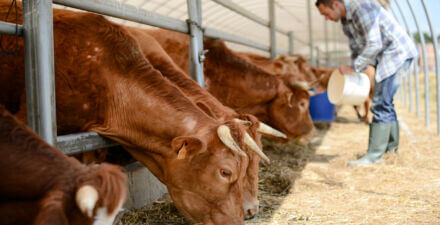Explore Equitable Growth’s current work in our Value Added blog.
Consider Jared Diamond’s 1987 paean to hunter gatherers. While I find his article provocative and insightful, I also find it annoying. It seems to me that it mostly misses the most important parts of the story.
For one thing, it misses the importance of the dominant Malthusian mechanisms. The invention of agriculture and the domestication of animals provide an enormous technological boost to humanity both in terms of the number of calories that can be harvested by an hour of work and in terms of the ability of a society to make durable investments of all kinds that further boost its productivity. It is an absolute living-standard bonanza for the generations that discover it, and the generations that come after.
So what goes wrong with quality of life among agriculturalists? Well, without rapid technological progress and before the demographic transition, human populations and living standards tend to settle at a point where, given nutrients, hazards of life, and societal institutions, every mother has on average one daughter who herself reproduces. The standard of living will be whatever standard of living makes that happen. And, for agriculturalists–without the hazards to adults of travel and hunting, and without the hazards a mobile lifestyle imposes on the very young–that standard of living is a lot lower than among hunter-gatherers. Lifespan looks about the same looking across hunter-gatherers and agriculturalists. Biomedical and fitness indicators are much much higher for hunter-gatherers.
Whether this is a “disaster” or not depends on the answer to the old utilitarian conundrum of whether it is better to have a few people who live very well or a lot of people who live very poorly. This is an open question in philosophy, but Diamond appears to think that it is a closed one. And Diamond ignores the important consideration that only the density of population that comes with agriculture can generate enough human brains thinking to allow us to–quite possibly–transcend our Malthusian limits and create a truly human world in the long run.
 Competitive Edge
Competitive Edge
By
Hiba Hafiz,
Nathan Miller,
February 18, 2021
 post
post
As to inequality … violence … domination … In my view it is difficult to say on net. Certainly the agricultural epoch has many many more people reaping where they did not sow and gathering where they did not scatter. Nevertheless, taking all three together, I cannot judge whether there was either a positive or a negative change across the boundary of the Neolithic Revolution. More inequality and domination, certainly. But you also have many more interactions between humans that are not one-shot interactions: people have fixed addresses, after all. If we know anything about humans, it is that human males have a tendency to resort to violence–perhaps not as great a tendency as chimps or gorillas, but a tendency, and we make more deadly weapons. It is not at all clear to me that the hunter-gatherer epoch had less murder, rape, kidnapping and enslavement of women, and so forth than did the agricultural epoch.
The hunter-gatherer age was not a kumbaya-singing age. Where, after all, are the Neanderthals today?
Jared Diamond (1987): The Worst Mistake in the History of the Human Race: Discover (May), pp. 64-66: “Archaeology is demolishing another sacred belief: that human history over the past million years has been a long tale of progress…
…The adoption of agriculture, supposedly our most decisive step toward a better life, was in many ways a catastrophe from which we have never recovered. With agriculture came the gross social and sexual inequality, the disease and despotism, that curse our existence…. For most of our history we supported ourselves by hunting and gathering: we hunted wild animals and foraged for wild plants. It’s a life that philosophers have traditionally regarded as nasty, brutish, and short…. Our escape from this misery was facilitated only 10,000 years ago, when in different parts of the world people began to domesticate plants and animals. The agricultural revolution spread until today it’s nearly universal and few tribes of hunter-gatherers survive…. Planted crops yield far more tons per acre than roots and berries. Just imagine a band of savages, exhausted from searching for nuts or chasing wild animals, suddenly grazing for the first time at a fruit-laden orchard or a pasture full of sheep. How many milliseconds do you think it would take them to appreciate the advantages of agriculture?…. The progressivist party line sometimes even goes so far as to credit agriculture with the remarkable flowering of art…. Agriculture gave us free time that hunter-gatherers never had. Thus it was agriculture that enabled us to build the Parthenon and compose the B-minor Mass….
While farmers concentrate on high-carbohydrate crops like rice and potatoes, the mix of wild plants and animals in the diets of surviving hunter-gatherers provides more protein and a better balance of other nutrients…. The lives of at least the surviving hunter-gatherers aren’t nasty and brutish, even though farmers have pushed them into some of the world’s worst real estate…. The progressivist view is really making a claim about the distant past: that the lives of primitive people improved when they switched from gathering to farming. Archaeologists can date that switch by distinguishing remains of wild plants and animals from those of domesticated ones in prehistoric garbage dumps….
Usually the only human remains available for study are skeletons, but they permit a surprising number of deductions…. keletons from Greece and Turkey show that the average height of hunger-gatherers toward the end of the ice ages was a generous 5’9″ for men, 5’5″ for women. With the adoption of agriculture, height crashed, and by 3000 B. C. had reached a low of only 5’3″ for men, 5′ for women. By classical times heights were very slowly on the rise again, but modern Greeks and Turks have still not regained the average height of their distant ancestors…. Burial mounds in the Illinois and Ohio river valleys… a hunter-gatherer culture gave way to intensive maize farming around A. D. 1150…. These early farmers paid a price for their new-found livelihood. Compared to the hunter-gatherers who preceded them, the farmers had a nearly 50 per cent increase in enamel defects indicative of malnutrition, a fourfold increase in iron-deficiency anemia (evidenced by a bone condition called porotic hyperostosis), a theefold rise in bone lesions reflecting infectious disease in general, and an increase in degenerative conditions of the spine, probably reflecting a lot of hard physical labor. ‘Life expectancy at birth in the pre-agricultural community was bout twenty-six years,’ says Armelagos, ‘but in the post-agricultural community it was nineteen years. So these episodes of nutritional stress and infectious disease were seriously affecting their ability to survive.’ The evidence suggests that the Indians at Dickson Mounds, like many other primitive peoples, took up farming not by choice but from necessity in order to feed their constantly growing numbers. ‘I don’t think most hunger-gatherers farmed until they had to, and when they switched to farming they traded quality for quantity,’ says Mark Cohen of the State University of New York at Plattsburgh, co-editor with Armelagos, of one of the seminal books in the field, Paleopathology at the Origins of Agriculture. ‘When I first started making that argument ten years ago, not many people agreed with me. Now it’s become a respectable, albeit controversial, side of the debate.’
There are at least three sets of reasons to explain the findings that agriculture was bad for health… a varied diet… [vs] one or a few starchy crops. The farmers gained cheap calories at the cost of poor nutrition…. Because of dependence on a limited number of crops, farmers ran the risk of starvation if one crop failed. Finally, the mere fact that agriculture encouraged people to clump together… led to the spread of parasites and infectious disease….
Besides malnutrition, starvation, and epidemic diseases, farming helped bring another curse upon humanity: deep class divisions. Hunter-gatherers have little or no stored food, and no concentrated food sources, like an orchard or a herd of cows: they live off the wild plants and animals they obtain each day. Therefore, there can be no kings, no class of social parasites who grow fat on food seized from others. Only in a farming population could a healthy, non-producing elite set itself above the disease-ridden masses. Skeletons from Greek tombs at Mycenae c. 1500 B. C. suggest that royals enjoyed a better diet than commoners, since the royal skeletons were two or three inches taller and had better teeth (on the average, one instead of six cavities or missing teeth). Among Chilean mummies from c. A. D. 1000, the elite were distinguished not only by ornaments and gold hair clips but also by a fourfold lower rate of bone lesions caused by disease…. Farming may have encouraged inequality between the sexes, as well. Freed from the need to transport their babies during a nomadic existence, and under pressure to produce more hands to till the fields, farming women tended to have more frequent pregnancies than their hunter-gatherer counterparts — with consequent drains on their health….
Thus with the advent of agriculture and elite became better off, but most people became worse off. Instead of swallowing the progressivist party line that we chose agriculture because it was good for us, we must ask how we got trapped by it despite its pitfalls. One answer boils down to the adage ‘Might makes right.’ Farming could support many more people than hunting, albeit with a poorer quality of life. (Population densities of hunter-gatherers are rarely over on person per ten square miles, while farmers average 100 times that.)… As population densities of hunter-gatherers slowly rose at the end of the ice ages, bands had to choose between feeding more mouths by taking the first steps toward agriculture, or else finding ways to limit growth. Some bands chose the former solution… outbred and then drove off or killed the bands that chose to remain hunter-gatherers, because a hundred malnourished farmers can still outfight one healthy hunter….
Hunter-gatherers practiced the most successful and longest-lasting life style in human history. In contrast, we’re still struggling with the mess into which agriculture has tumbled us, and it’s unclear whether we can solve it. Suppose that an archaeologist who had visited from outer space were trying to explain human history to his fellow spacelings. He might illustrate the results of his digs by a 24-hour clock on which one hour represents 100,000 years of real past time. If the history of the human race began at midnight, then we would now be almost at the end of our first day. We lived as hunter-gatherers for nearly the whole of that day, from midnight through dawn, noon, and sunset. Finally, at 11:54 p. m. we adopted agriculture. As our second midnight approaches, will the plight of famine-stricken peasants gradually spread to engulf us all? Or will we somehow achieve those seductive blessings that we imagine behind agriculture’s glittering facade, and that have so far eluded us?
Diamond is broadly right in what he says:
Carles Boix and Frances Rosenbluth: Bones of Contention: The Political Economy of Height Inequalty: “Human osteological data provide a rich, unmined source of information…
…about the distribution of nutrition, and by extension, the distribution of political power and economic wealth, in societies of long ago. On the basis of data we have collected and analyzed, we find that the shift from a hunter–gatherer to a labor-intensive agriculture opened up inequalities that had discernible effects on human health and stature. But we also find that political institutions intervene decisively in affecting the distribution of resources within societies. Political institutions appear to be shaped not only by economic factors but also by military technology and vulnerability to invasion, leaving important questions for additional exploration.



